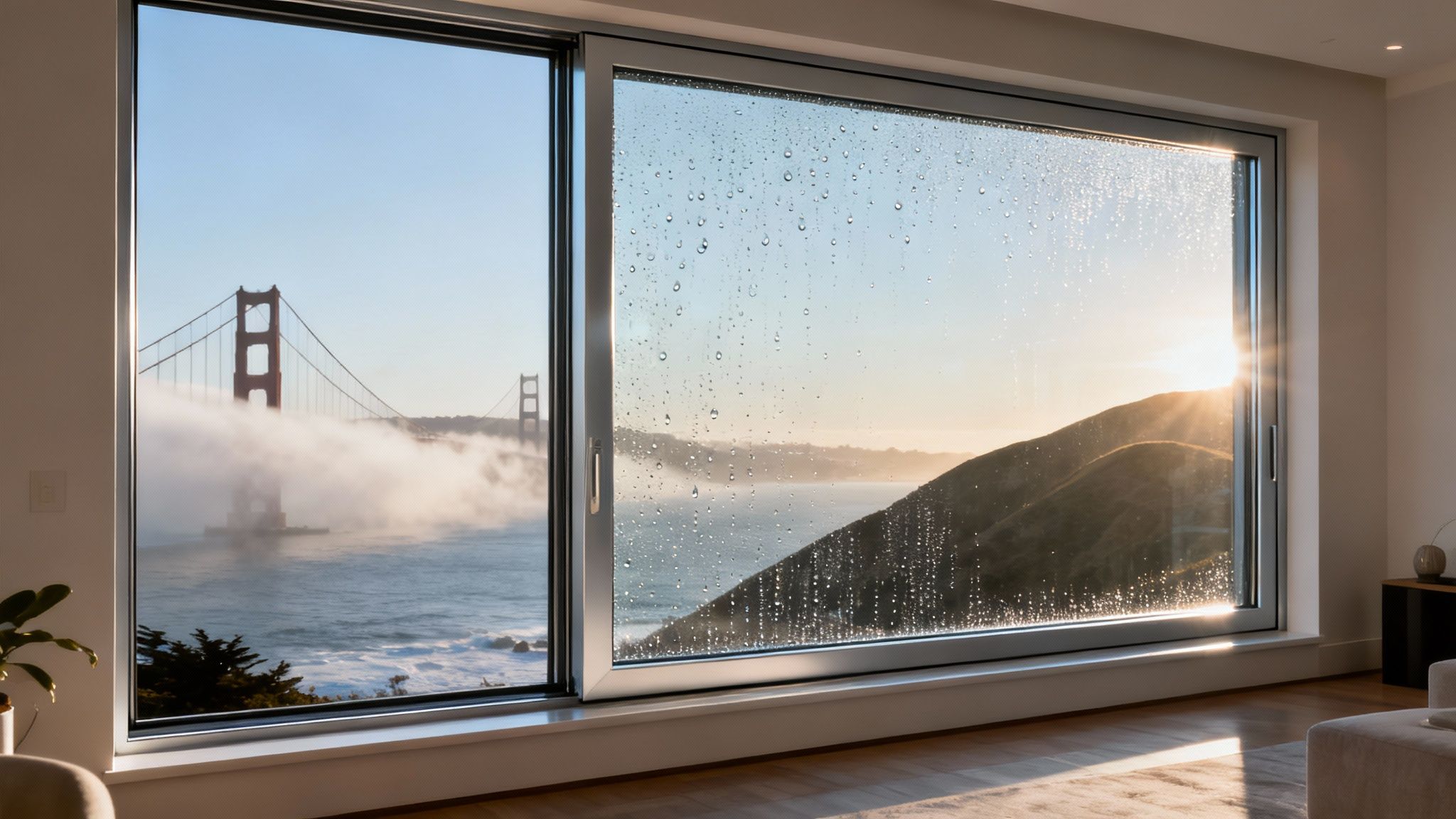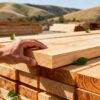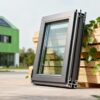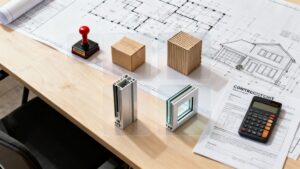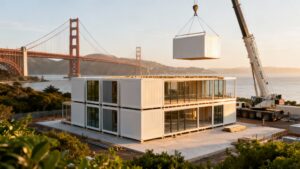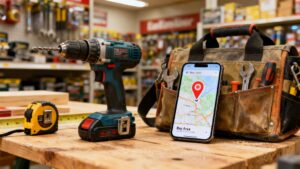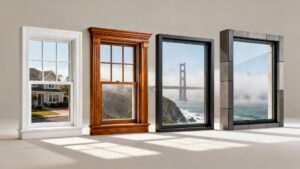To stand a chance against the Bay Area's unique weather, an all-weather window needs to be tough. We're talking about a combination of corrosive salt air, driving rain, intense sun, and even seismic shifts. The best windows feature durable, non-corrosive frames—like thermally broken aluminum or rugged fiberglass—and insulated glass with special Low-E coatings. This is an investment in long-term performance that can handle our demanding local climates.
Why Bay Area Homes Need Specialized All-Weather Windows
Living in the Bay Area means dealing with many different microclimates. These conditions can be brutal on ordinary building materials. From the salty coastal fog in San Francisco to the dry heat on an Oakland hillside, standard windows just don't last.
Choosing the right all-weather windows built to withstand the Bay Area is critical. It's an investment in your home's longevity, comfort, and protection. A window that works in a sheltered San Jose neighborhood could fail completely on a coastal property.
The Unique Challenges of Our Local Climate
Homes from the Berkeley hills to the coast face a constant environmental assault. To choose windows that will last for decades, you must understand these challenges.
Here are the key issues our region presents:
- Corrosive Salt Air: The salty marine layer carries moisture from the Pacific. This causes metal on standard windows to rust, corrode, and fail prematurely.
- Wind-Driven Rain: Our winter storms bring heavy rain and high winds. This weather can force water past weak window seals, leading to leaks and costly damage.
- Rapid Temperature Swings: It’s common to go from a cool, foggy morning to a hot, sunny afternoon. This daily cycle causes window materials to expand and contract, putting strain on frames and seals.
- Seismic Forces: This is earthquake country. Homes here need windows with strong, resilient frames that can handle ground movement without warping or cracking.
This infographic breaks down how modern windows are engineered to fight back against these specific Bay Area challenges.
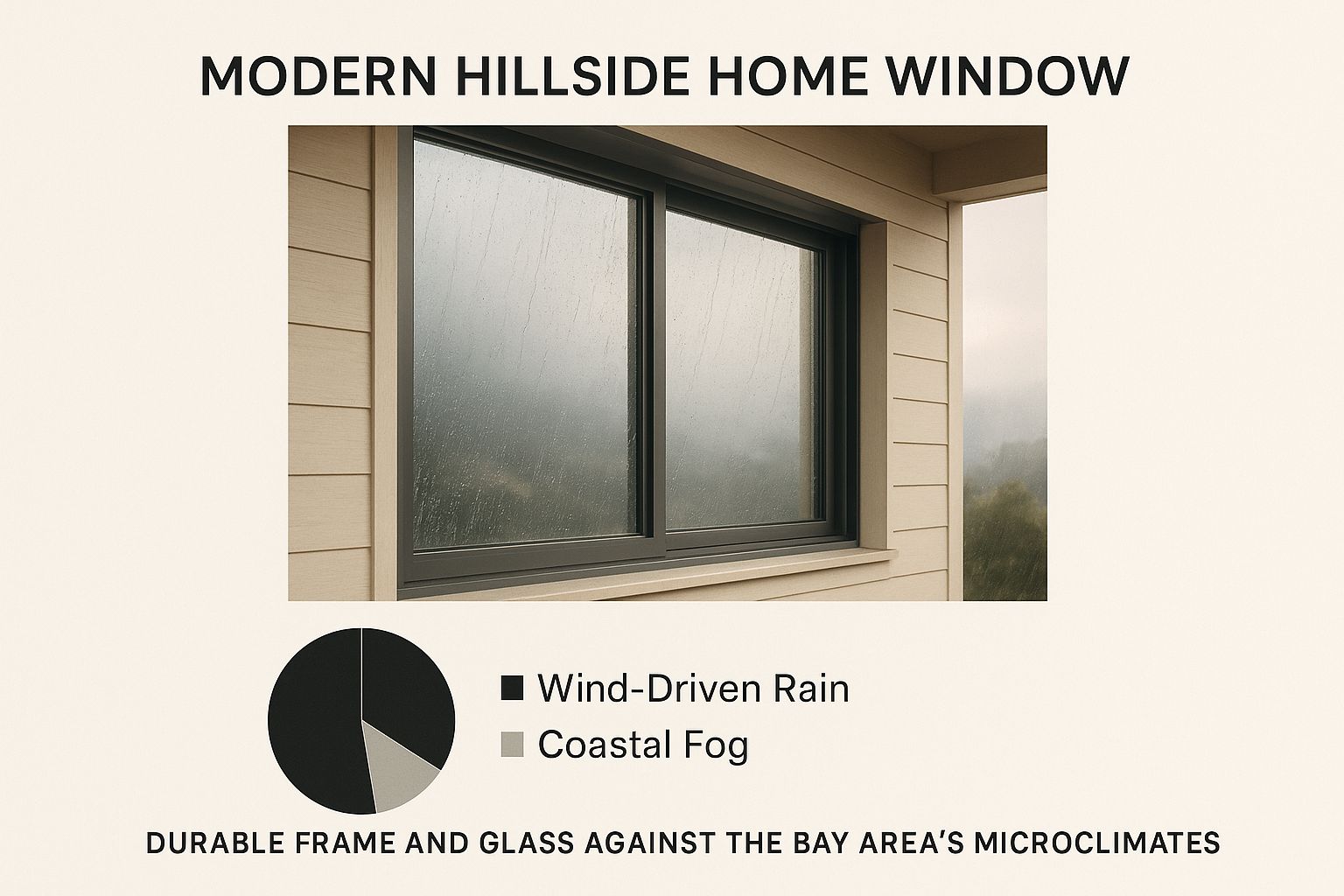
Alt text: Infographic showing how all-weather windows resist salt air, rain, and seismic shifts with features like durable frames and insulated glass.
Features like advanced frame materials and specialized glass work together to create a barrier against our region's toughest conditions. To learn more, our guide on weatherproofing windows and doors has more expert strategies. Choosing windows designed for these pressures is a major upgrade to your home’s defense system.
How to Read Window Performance Ratings for Our Climate
When you look at a new window's label, the technical numbers can be confusing. For builders and homeowners in the Bay Area, only a couple of these ratings really matter. They help you create a home that’s both comfortable and efficient.
Understanding these ratings is key to choosing all-weather windows built to withstand the Bay Area’s unique climate. This includes foggy Berkeley mornings and hot Oakland afternoons.
The National Fenestration Rating Council (NFRC) provides the standardized ratings on every window sticker. For our region, the two most important metrics are the U-Factor and the Solar Heat Gain Coefficient (SHGC).
U-Factor: How Well a Window Insulates
The U-Factor tells you how well a window prevents heat from escaping your home. It measures insulation on a scale from 0.20 to 1.20.
The rule is simple: the lower the U-Factor, the better the window insulates. A window with a low U-Factor keeps your home’s warmth inside. This is crucial for keeping heating costs down during our cool, damp winters.
SHGC: How Well a Window Blocks Solar Heat
The Solar Heat Gain Coefficient (SHGC) measures how much heat from the sun a window allows into your home. The rating is a number between 0 and 1.
A lower number is usually better. The lower the SHGC, the less solar heat the window lets in. A low SHGC is perfect for south- and west-facing windows that get blasted by afternoon sun, keeping your home cool.
Key Window Performance Ratings for Bay Area Homes
| Performance Metric | What It Measures | Ideal Bay Area Rating |
|---|---|---|
| U-Factor | How well the window prevents heat from escaping (insulation) | Low (typically 0.30 or less) |
| SHGC | How much solar heat the window blocks from entering | Low (typically 0.25 or less) |
Balancing these two ratings is the secret to year-round comfort in the Bay Area. For most projects, you want a window with a low U-Factor and a carefully chosen SHGC. Nailing this choice means lower PG&E bills and a more comfortable home. Before you finalize any decisions, our window inspection checklist offers a great framework to follow.
Choosing Frame Materials and Glass for Lasting Durability
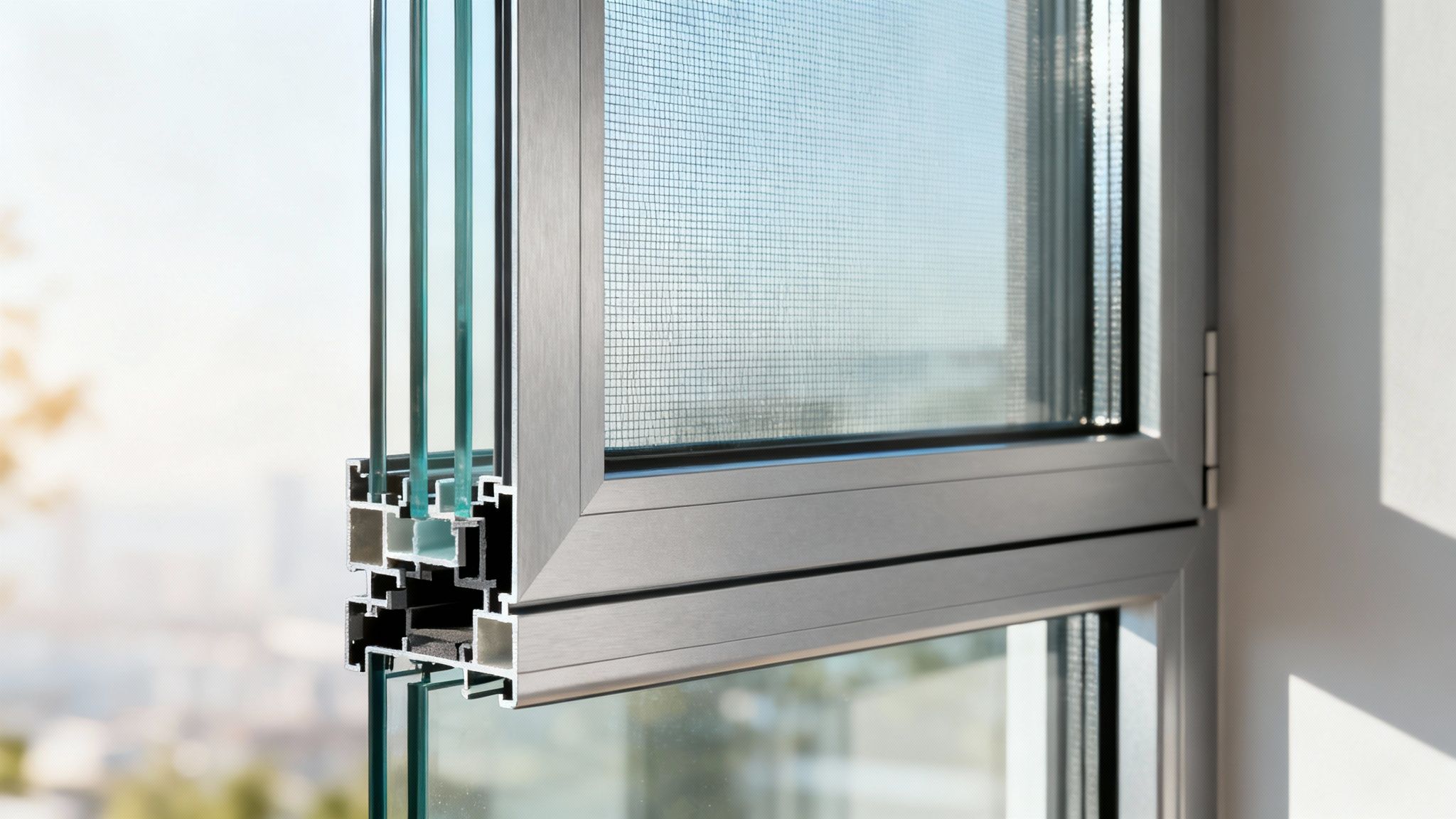
Alt text: Close-up of a durable all-weather window frame with insulated glass designed for Bay Area homes.
A high-performance window is an engineered system where the frame and glass work together. For Bay Area homes, this combination is your first line of defense against salt air, rain, and seismic shifts. The durability of all-weather windows built to withstand the Bay Area starts with picking the right materials.
High-Performance Frame Materials
The frame is the window's backbone. It provides structural integrity to stand up to the elements. Not all materials are equal, especially in our corrosive coastal conditions.
Here are the leading options that perform best locally:
- Thermally Broken Aluminum: Modern aluminum frames feature a "thermal break"—a non-conductive strip separating the inside and outside frame. This stops heat transfer, boosting energy efficiency. This material offers incredible strength and a sleek look that won’t corrode in salty air.
- Fiberglass: Fiberglass is known for its exceptional strength and stability. It barely expands or contracts with temperature changes, meaning its seals stay tight year after year. This makes it a great choice for areas with dramatic temperature swings, like the hills of Berkeley or Oakland.
- Wood with Exterior Cladding: Clad windows offer the classic look of wood without the high maintenance. You get beautiful wood on the inside and a durable layer of aluminum or fiberglass on the outside. This cladding protects the wood from moisture and UV damage.
In our climate, a window's long-term performance is tied to its material. A frame that resists salt spray and doesn't warp under the sun is essential for a lasting, weathertight seal.
Advanced Glass Technology for Comfort and Protection
The glass itself is just as critical. Modern glass technology saves energy and protects your home’s interior from sun damage.
The most important feature is the Insulated Glass Unit (IGU). This is two (or three) panes of glass separated by a sealed space, often filled with an inert gas like argon. According to ENERGY STAR, this setup significantly reduces heat transfer, keeping your home warmer in winter and cooler in summer.
On top of that, Low-E (low-emissivity) coatings are a game-changer. These are microscopic metallic layers on the glass that block harmful UV rays, which cause furniture and floors to fade. They also reflect infrared heat, keeping your home more comfortable. Exploring the different types of quality windows in the East Bay shows how these technologies fit local needs.
Top Window Models for Bay Area Coastal and Hillside Homes
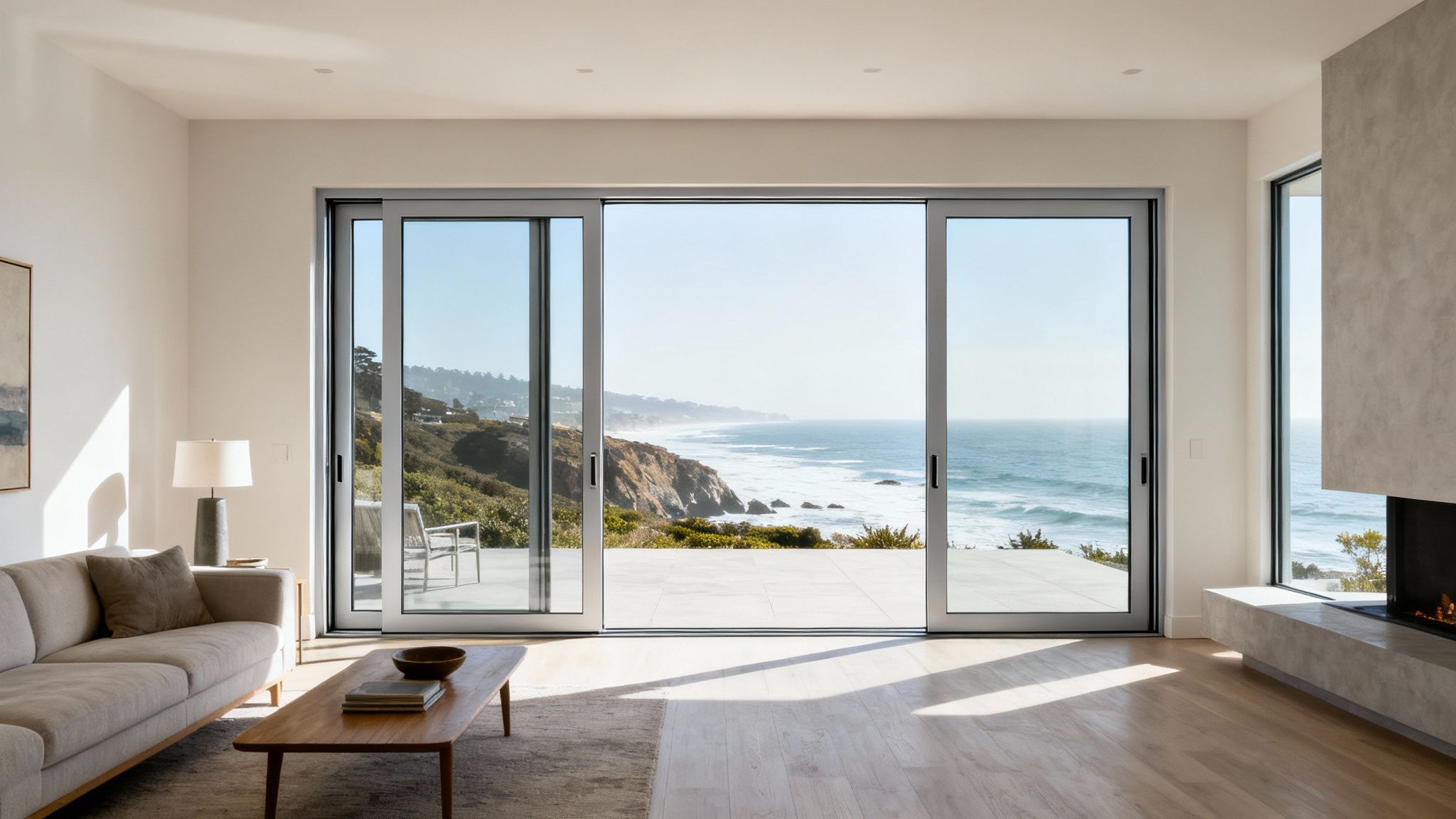
Alt text: A modern coastal home in the Bay Area featuring large, durable all-weather windows with stunning ocean views.
It helps to look at specific models from manufacturers who understand our demanding West Coast environment. These windows are engineered to perform reliably in homes on windy hillsides or in salty coastal air. For the most challenging projects, local builders and architects consistently turn to a few trusted product lines.
All Weather Architectural Aluminum: A Trusted Choice
All Weather Architectural Aluminum is a manufacturer that truly understands our regional challenges. They have spent over 50 years perfecting high-performance aluminum windows and doors for the West Coast. Their products are designed to handle the Bay Area's climate with a focus on thermal performance and durability.
What makes their products a go-to for local builds? It comes down to a few key features:
- Robust Thermal Breaks: These breaks effectively stop heat transfer, which makes a huge difference in a home's energy efficiency.
- Commercial-Grade Construction: Many of their products use components from commercial-grade designs. This results in superior strength and a longer lifespan.
- Superior Weather Sealing: Their advanced sealing technology creates a tight barrier against wind-driven rain and drafts.
Standout Models for Coastal and Hillside Applications
The Series 8100 Multi Slide Door System is a popular choice for homes that want a seamless indoor-outdoor flow without sacrificing weather protection. Its thermally broken aluminum frame provides excellent insulation and can handle massive openings. This makes it perfect for capturing views from an Oakland hills home.
For homes on the coast, a Modern Beach Homes Design Guide can provide ideas for blending style with resilience. It’s also smart to see what other trusted brands offer. Our guide on why Weather Shield doors and windows make great upgrade choices is a great place to compare solutions.
Real-World Performance: A recent project on a coastal Berkeley home used the All Weather Series 8100. The homeowner reported a huge reduction in wind noise during storms and zero condensation, even on foggy mornings. This shows the real-world value of a good thermal break and superior seals.
Picking the right model means matching proven engineering with the demands of your job site. By choosing products designed for our climate, you’re investing in long-term durability.
Real-World Insights from Local Builders and Installers
Technical specs are a great start, but the real test for any all-weather window built to withstand the Bay Area happens on the job site. The true measure of a window is how it holds up day after day, from foggy Berkeley mornings to hot afternoons in the Oakland Hills.
We've gathered insights from the builders and remodelers who install these products every day. Their firsthand experience is invaluable. They see the immediate impact of swapping old, drafty windows for high-performance ones. A common story is the disappearance of condensation on foggy mornings—a detail that prevents moisture damage.
Solving Common Bay Area Problems
Local installers tell us that the right windows solve some of the most persistent homeowner complaints in our region. These are practical solutions to daily frustrations.
Here are a few key problems that high-performance windows solve:
- Drastic Noise Reduction: For a home on a busy Berkeley street, the difference is night and day. The superior insulation and tight seals of a quality window can create a peaceful retreat.
- Enhanced Peace of Mind: When a winter storm rolls in, clients feel more secure knowing their windows can handle wind-driven rain.
- Protecting Interior Furnishings: Advanced Low-E coatings block damaging UV rays, stopping the fading of hardwood floors, furniture, and artwork.
Partnering with Proven Manufacturers and Installers
Builders value working with manufacturers who understand our regional needs. All Weather Architectural Aluminum has built a solid reputation in the Bay Area for over 50 years. They are known not just for their products but for being a stable, local employer. You can learn more about All Weather’s regional impact and growth.
One contractor recently told us, "We installed a full set of thermally broken aluminum windows in an El Cerrito home. The client was blown away. Their cooling costs dropped, and they didn't have to shut the blinds every afternoon."
A successful window installation comes down to the quality of the product and the skill of the installer. These firsthand accounts show the importance of pairing a superior window with a talented professional. Our guide on how to choose a contractor offers tips for finding a qualified pro.
Frequently Asked Questions About Bay Area Windows
1. What is the most important feature for windows in a coastal area like San Francisco or Berkeley?
For coastal homes, corrosion resistance is the top priority. The salt in our air can quickly damage standard window frames and hardware. Look for materials like thermally broken aluminum with a durable finish or high-quality fiberglass that are built to resist rust.
2. Are triple-pane windows necessary for the Bay Area climate?
For most Bay Area homes, triple-pane windows are not necessary. A high-quality double-pane window with a Low-E coating and argon gas fill provides an excellent balance of insulation, noise reduction, and value for our moderate climate.
3. How do all-weather windows handle seismic activity?
This is a critical question for our region. All-weather windows are built with stronger frames, reinforced corners, and robust glazing systems. This superior structural integrity helps them withstand the stress of ground movement during an earthquake, reducing the risk of a frame warping or glass shattering.
4. Can new windows really lower my PG&E bill?
Yes, absolutely. Old, leaky windows are a major source of energy loss. According to ENERGY STAR, replacing single-pane windows with certified energy-efficient models can lead to significant annual savings on energy bills.
5. What kind of warranty should I look for in a new window?
Look for a comprehensive warranty that covers both the window parts and the insulated glass unit against seal failure. Top manufacturers often offer warranties of 20 years or more on the glass and at least 10 years on hardware. This provides long-term peace of mind for your investment.
Get Expert Guidance for Your Bay Area Window Project
Choosing the right windows can be complex, but you don't have to do it alone. The best next step is to see the products and talk to professionals who understand Berkeley and Oakland building codes. Our team specializes in all-weather windows built to withstand the Bay Area climate.
We invite builders, contractors, architects, and homeowners to visit the Truitt & White showroom in Berkeley. Our specialists can walk you through the options and help you select the ideal windows for your project. We also know homeowners often use financial tools like home equity loans or HELOCs to invest in specialized windows that add long-term value.
Let our experts guide you from selection to installation. Connect with us to start your project today.


